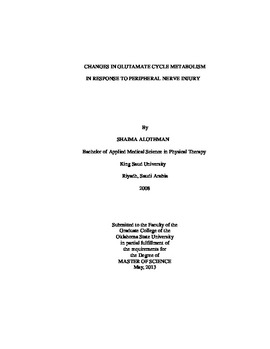| dc.contributor.advisor | Miller, Kenneth | |
| dc.contributor.author | Alothman, Shaima | |
| dc.date.accessioned | 2014-09-24T14:17:54Z | |
| dc.date.available | 2014-09-24T14:17:54Z | |
| dc.date.issued | 2013-05-01 | |
| dc.identifier.uri | https://hdl.handle.net/11244/11063 | |
| dc.description.abstract | Scope and Method of Study: Neuropathic pain is a common complication of peripheral nerve injuries. In pain studies, it has been revealed that glutamate neurotransmission has a critical role in the noxious stimulus sensation. The glutamate cycle have several well established markers: vesicular glutamate transporters 1 & 2 and glutaminase. However, systemic studies for vesicular glutamate transporters 1 & 2 and glutaminase changes after peripheral nerve injuries have not been done. Thus, in this thesis project we studied the changes in vesicular glutamate transporters 1 & 2 and glutaminase systemically through immunohistochemistry at six different time points that represent the acute (day 1 & 2), subacute (day 7 & 14), and chronic (day 28 & 70) phases in peripheral nerve regeneration. Our peripheral nerve injury models, nerve crush and nerve transection, imitate two types of peripheral nerve injury in human, axonotmesis and neurotemsis, respectively.Findings and Conclusions: The study of subacute phase of peripheral nerve regeneration in sciatic nerve crush model showed an elevation of dorsal root ganglia neurons VGLUT 2 immunoreactivity only at day 7 post injury. On the other hand, the study of VGLUT 1 & 2 and glutaminase dorsal root ganglia neurons immunoreactivity in the acute, subacute, and chronic phase of regeneration showed a pattern of elevation and reduction in the glutamate metabolism cycle. A minor increase in the three markers immunoreactivity at day 1 followed by marked decrease at day 2. In subacute phase VGLUT 1 & 2 and glutaminase immunoreactivity levels return to control levels at day 7, however, at day 14 they showed an increase above control levels. Finally at the chronic phase of regeneration, the three markers show a decrease in immunoreactivity levels initially (day 28) then return to control levels at day 70 post injury. In conclusion, our immunohistochemistry studies for vesicular glutamate transporters 1 & 2 and glutaminase gave insight into part of the story of neuronal response to injury. By understanding the molecular and physiological changes after peripheral nerve injuries, potential pharmacological or other treatments could be designed to improve the functional outcome of those injuries. | |
| dc.format | application/pdf | |
| dc.language | en_US | |
| dc.publisher | Oklahoma State University | |
| dc.rights | Copyright is held by the author who has granted the Oklahoma State University Library the non-exclusive right to share this material in its institutional repository. Contact Digital Library Services at lib-dls@okstate.edu or 405-744-9161 for the permission policy on the use, reproduction or distribution of this material. | |
| dc.title | Changes in Glutamate Cycle Metabolism in Response to Peripheral Nerve Injury | |
| dc.type | text | |
| dc.contributor.committeeMember | Daivs, Randall | |
| dc.contributor.committeeMember | Wilson, Nedra | |
| osu.filename | Alothman_okstate_0664M_12793.pdf | |
| osu.accesstype | Open Access | |
| dc.description.department | Biochemistry & Molecular Biology | |
| dc.type.genre | Thesis | |
